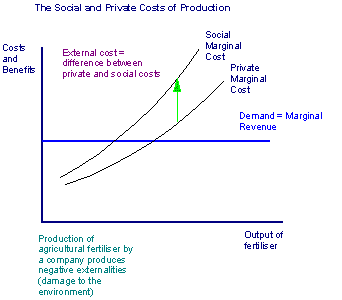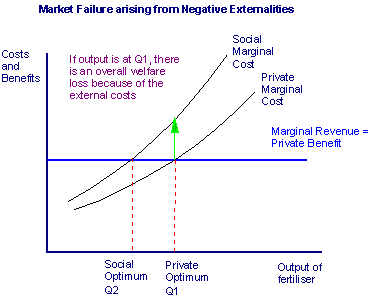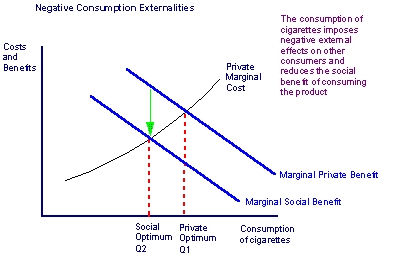Online Course
NDNP 803 - Executive Leadership and Healthcare Economics
Module 7: The Production of Externalities in Health Care
Divergences from a Competitive Market
Understanding Externalities
Externalities are common in virtually every area of economic activity. They are defined as third party (or spill-over) effects arising from the production and/or consumption of goods and services for which no appropriate compensation is paid. Externalities can cause market failure if the price mechanism does not take into account the full social costs and social benefits of production and consumption. The study of externalities by economists has become extensive in recent years - not least because of concerns about the link between the economy and the environment.
Private and Social Costs
Externalities create a divergence between the private and social costs of production. Social cost includes all the costs of production of the output of a particular good or service. We include the third party (external) costs arising, for example, from pollution of the atmosphere.
For example: - a chemical factory emits wastage as a by-product into nearby rivers and into the atmosphere. This creates negative externalities which impose higher social costs on other firms and consumers. e.g. clean up costs and health costs.
Another example of higher social costs comes from the problems caused by traffic congestion in towns, cities and on major roads and motor ways.
It is important to note though that the manufacture, purchase and use of private cars can also generate external benefits to society. This why cost-benefit analysis can be useful in measuring and putting some monetary value on both the social costs and benefits of production.
In conclusion: private costs + externalities = social costs
Market Failure and Externalities
Where there is negative production, externalities exist. This is shown in the diagram below where the marginal social cost of production exceeds the private costs faced only by the producer/supplier of the product. In our example a supplier of fertilizer to the agricultural industry creates some external costs to the environment arising from their production process.

Externalities and Market Failure
If we assume that the producer is interested in maximizing profits - then they will only take into account the private costs and private benefits arising from their supply of the product. We can see from the diagram below that the profit-maximizing level of output is at Q1. However the socially efficient level of production would consider the external costs too. The social optimum output level is lower at Q2.

This leads to the private optimum output being greater than the social optimum level of production. The producer creating the externality does not take the effects of externalities into their own calculations. We assume that producers are only concerned with their own self-interest.
In the diagram above, the private optimum output is when where private marginal benefit = private marginal cost, giving an output of Q1.For society as a whole though the social optimum is where social marginal benefit = social marginal cost at output Q2.The failure to take into account the negative externality effects is an example of market failure.
Negative Consumption and Externalities
Consumers can create externalities when they purchase and consume goods and services.
- Pollution from cars and motorbikes
- Litter on streets and in public places
- Noise pollution from using car stereos or ghetto-blasters
- Negative externalities created by smoking and alcohol abuse
- Externalities created through the mistreatment of animals
- Vandalism of public property
- Negative externalities arising from crime
In these situations the marginal social benefit of consumption will be less than the marginal private benefit of consumption. (i.e. SMB < PMB) This leads to the good or service being over-consumed relative to the social optimum. Without government intervention the good or service will be under-priced and the negative externalities will not be taken into account. Again there will be a deadweight loss of economic welfare.

In the example shown in the chart above we illustrate the potentially negative effects of people consuming cigarettes on other consumers. The disutility (dis-satisfaction) created leads to a reduction in the overall social benefit of consumption. If the cigarette consumer only considers their own private costs and benefits, then there will be over-consumption of the product. Ideally, the socially efficient level of cigarette consumption will be lower (Q2). The issue is really which policies/strategies are most appropriate in reducing the total level of cigarette consumption!
To learn more about market failure:
Part II: Negative Externalities of Consumption
Part III: Positive Externalities
Now, for some fun: TOP TEN MARKET FAILURES!!
This website is maintained by the University of Maryland School of Nursing (UMSON) Office of Learning Technologies. The UMSON logo and all other contents of this website are the sole property of UMSON and may not be used for any purpose without prior written consent. Links to other websites do not constitute or imply an endorsement of those sites, their content, or their products and services. Please send comments, corrections, and link improvements to nrsonline@umaryland.edu.